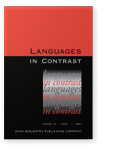Vol. 21:1 (2021) ► pp.58–81
Coherence relations across speech and sign language
A comparable corpus study of additive connectives
This paper provides the first contrastive analysis of a coherence relation (viz. addition) and its connectives across a sign language (French Belgian Sign Language) and a spoken language (French), both used in the same geographical area. The analysis examines the frequency and types of connectives that can express an additive relation, in order to contrast its “markedness” in the two languages, that is, whether addition is marked by dedicated connectives or by ambiguous, polyfunctional ones. Furthermore, we investigate the functions of the most frequent additive connective in each language (namely et and the sign SAME), starting from the observation that most connectives are highly polyfunctional. This analysis intends to show which functions are compatible with the meaning of addition in spoken and signed discourse. Despite a common core of shared discourse functions, the equivalence between et and SAME is only partial and relates to a difference in their semantics.
Article outline
- 1.Introduction
- 2.Background
- 2.1A brief history of sign language linguistics and LSFB
- 2.2Coherence relations and connectives
- 2.3Contrastive and cross-modal studies of connectives
- 2.4Objectives of the study
- 3.Methodology
- 3.1Data
- 3.2Annotation
- 4.Results
- 4.1Additive connectives in spoken French and LSFB
- 4.2Functions of et and SAME beyond addition
- 4.2.1Functions
- 4.2.2Domains
- 5.Conclusion
- Notes
-
References
